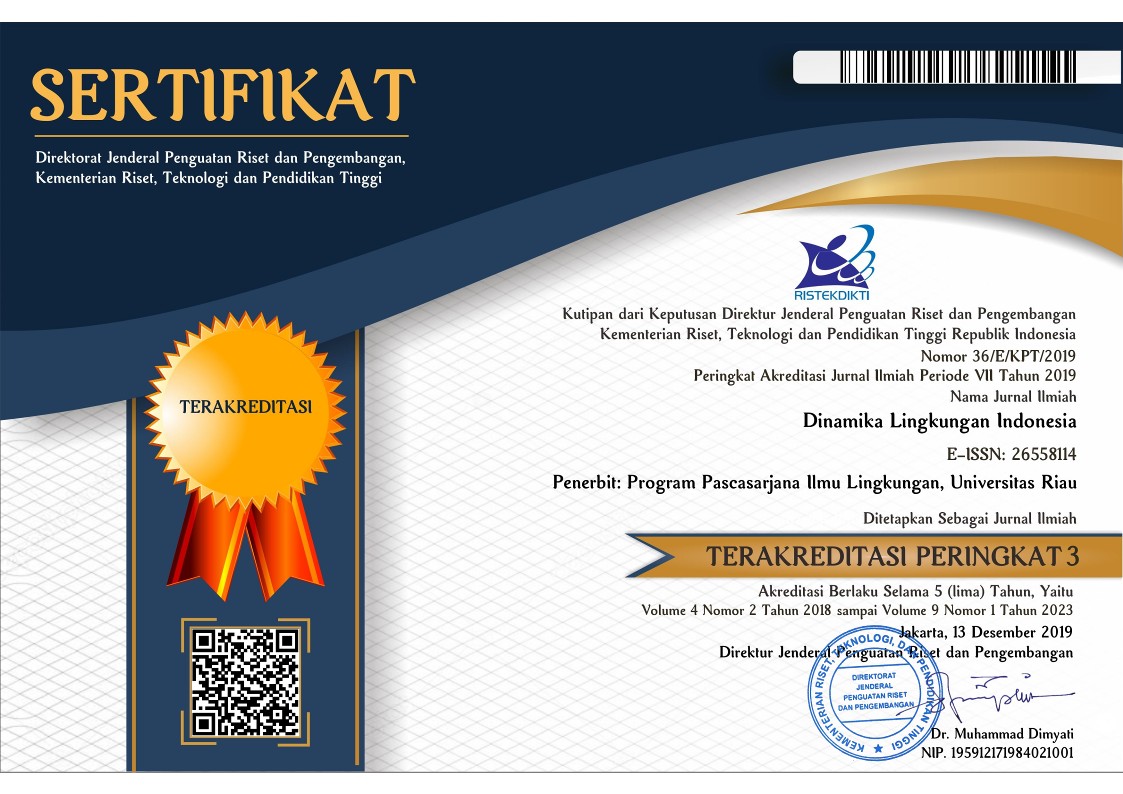Analisis Densitas Bentik Dinoflagellata Gambierdiscus, Ostreopsis dan Prorocentrum di Pantai Nirwana, Padang
Abstract
Environmental degradation has occurred in various ecosystems in the world. This also carries out in the sea and even sometimes threaten human life, whether directly or indirectly. Likewise, events in the marine environment associated with poisoning, caused by toxic algae such as dinoflagellates. To see the progress the survey research was conducted on Thallasia sp to see the growth of toxic dinoflagellates Gambierdiscus, Ostreopsis and Prorocentrum in the Nirwana Coast Padang. The data analysis uses two-way statistics with Turkey's Advanced Test. The results showed that Gambierdiscus and Ostreopsis almost the same number and were still low. High striking results occurred on Prorocentrum which differed markedly from both Gambierdiscus and Ostreopsis. This results also significantly different among stations.
Keywords
Full Text:
PDFReferences
Aligizaki, K. G., & Nikolaidis. (2006). The presence of the potentially toxic genera Ostreopsis and Coolia (Dinophyceae) in the North Aegean sea, Greece, Harmful Algae 5, p. 717-730.
Al-Has, A., & Mohammad-Noor, N. (2011). Identification of marine sand-dwelling dinoflagellates in Dinawan Island, Sabah. Borneo Science. 37-45.
Caillaud, A., Fraga, S., Aligizaki, K., Mohammad-Noor, N., Nikolaidis, G., Moestrup, Ø., & Diogène, J. (2009), Desarrollo de un ensayo celular para la detección de maitotoxinas en Gambierdiscus spp. Estudio comparativo entre cepas de distintas procedencias. X Reuniao Oberica, Fitoplancton Toxico e Biotoxinas, Lisbon.
Chui-Pin, L., L. Po-Teen, C. Kok-Wah, N. Boon-Koon & G. Usup. (2010). Morphology and molecular characterization of a new spesies of thecate bnethic dinoflagellate, coolia malayensis sp. NOV. (Dinophyceae)1. J. Phycol. 46, 162–171.
Chui-Pin, L.,Po-Teen L.,Toh-Hii T., Tuan-Halim, T. N., Kok-Wah C., Boon-Koon N. & Usup G. (2011).First report of the benthic dinoflagellate, ambierdiscus belizeanus (Gonyaulacales: Dinophyceae) for the east coast of Sabah, Malaysian Borneo. Phycological Research.59:143–146.
Harrness. (2005). Harmful Algal Research and Response: A National Environ-mental Science.
Holmes, M.J., Lee, F.C., Ming Teo, S.L., Woo Khoo, H. (1998). A survey of benthic dinoflagellates on Singapore reefs. In: Reguera B, Blanco J, Fernández ML, Wyatt T (eds) Harmful algae. Intergovernmental Oceanographic Commission of UNESCO, Xunta de Galicia, Vigo, p 50–51.
Ismael, A.A. & Halim, Y. (2006), First record of Ostreopsis spp. in Egyptian waters with a description of O. mediterraneus n. sp. 12th International conference on Harmful Algae, Copenhagen, pp. 197.
Iwataki, M.H., Kawami, N., Van Nguyen,L. Quang Doc,T. That Phap,Y. Fukuyoand K. Matsuoka. (2009). Cellular and body scale morphology of Heterocapsa huensis sp. nov. (Peridiniales, Dinophyceae) found in Hue, Vietnam. Phycological Research; 57: 87–93.
Kaly, U. & Jones, G.P. (1994). Test of the effect of disturbance on ciguatera in Tuvalu. Memoirs of the Queensland Museum 34, 523-532.
Lewis, R.L. (2001). The changing face of ciguatera. Toxicon 39, 97-106.
Loeblich, A. R. III (1968). A new marine dinoflagellate genus, Cachonina, in axenic culture from the Salton Sea, California with remarks on the genus Peridinium. Proc. Biol. Soc. Wash. 81: 91–6.
Masó, M., Garcés, E., Pages, F., Camp, J. (2003), Drifting plastic debris as a potential vector for dispersing Harmful Algal Bloom (HAB) species, Scientia Marina 67, p. 107-111.
Mohammad-Noor, N., Daugbjerg, N., Moestrup, Ø., & Anton, A. (2007). Marine epibenthic dinoflagellates from Malaysia – a study of live cultures & preserved samples based on light & scanning electron microscopy. Nordic Journal of Botany 24(6): 629-690.
Murray, S., Hoppenrath, M., Larsen, J., & Patterson, D.J. (2006). Bysmatrum teres sp. nov., a new sand-dwelling dinoflagellate from north-western Australia. Phycologia 45: 161–167.
Norris, D.R., Bomber, J.W., Balech, E. (1985). Benthic dinoflagellates associated with ciguatera from the Florida Keys. I. Ostreopsis heptagona sp. nov. In: Anderson DM, White AW, Baden DG (eds) Toxic dinoflagellates. Elsevier Science, New York, p 39–44.
Omura, T., Iwataki, M., Borja, V. M., Takayama, H., & Fukuyo, Y. (2013). Marine Phytoplakton of Western Pacific. Kouseisha Kouseiki Co., Ltd. Tokyo. 160 halaman..
Park, D.L. (1994). Reef Management and seafood monitoring programs for ciguatera. Memoirs of the Queensland Muesum 34, 587-594.
Parsons, M.L., Aligizaki, K., Bottein, M.D., Fraga, S., Morton, S.L., Penna, A., & Rhodes, L. (2012). Gambierdiscus and Ostreopsis: Reassessment of the state of knowledge of their taxonomy, geography, ecophysiology, and toxicology. Harmful Algae 14: 107–129.
Pearce, I., J.A. Marshall., & Hallegraeff, G.M. (2001). Toxic epiphytic dinoflagellates from east coast Tasmania, Australia. In: Hallegraeff GM, Blackburn SI, Bolch CJ, Lewis RJ (eds) Harmful algal blooms 2000. Intergovernmental Oceanographic Commission of UNESCO, Hobart, Tasmania, p 54–57.
Penna, A., Vila, M., Fraga., S., Giacobbe, M.G., Andreoni, F., Riobó, P. & Vernesi, C. (2005). Characterization of Ostreopsis and Coolia (Dinophyceae) isolates in the western Mediterranean Sea based on morphology, toxicity and internal transcribed spacer 5.8s rDNA sequences, Journal of Phycology 41, p. 212-225.
Pottier, I., Vernoux, J.P., & Lewis, R.J. (2001). Ciguatera fish poisoning in the Caribbean Islands and Western Atlantic. Rev. Environ. Contam. Toxicol. 168, 99-141.
Roy, R.N. (1977). Red tide & outbreak of paralytic poisoning in Sabah. Medical Journal of Malaysia 31: 247-251.
Sansoni, G., Borghini, B., Camici, G., Casotti, M., Righini, P., & Rustighi, C. (2003). Fioriture algali di Ostreopsis ovata (Gonyaulacales: Dinophyceae): un problema emergente, Biologia Ambientale 17, p. 17-23.
Turki, S. (2005). Distribution of toxic dinoflagellates along the leaves of seagrass Posidonia oceanica and Cymodocea nodosa from the Gulf of Tunis, Cahiers De Biologie Marine 46, p. 29-34.
Vila, M., Garcés, E., & Masó, M. (2001). Potentially toxic epiphytic dinoflagellate assemblages on macroalgae in the NW Mediterranean, Aquatic Microbial Ecology 26, p. 51-60.
Watanabe, M. M., M. Kawachi, M. Hiroki, and F. Kasai. (2000). NIES-collection. List of Strains, 6th edn. Microalgae and Protozoa. National Institute of Environmental Studies, Tsukuba, Japan, 159 pp.
YESOU. (2013). Use of Artificial Subtrate to Assee Field Abundance of Banthic HAB (BHAB) Dinoplagellates. Project Imformation and Methods. 9 halaman.
Yamaguchi, M., Itakura, S., Nagasaki, K., Matsuyama, Y., Uchida, T., & Imai, M. (1997). Effects of temperature and salinity on the growth of the red tide flagellates Heterocapsa circularisquama (Dinophyceae) and Chattonella verruculosa (Raphidophyceae). J. Plankton Res. 19: 1167–74.
DOI: http://dx.doi.org/10.31258/dli.7.2.p.116-121
Refbacks
- There are currently no refbacks.





